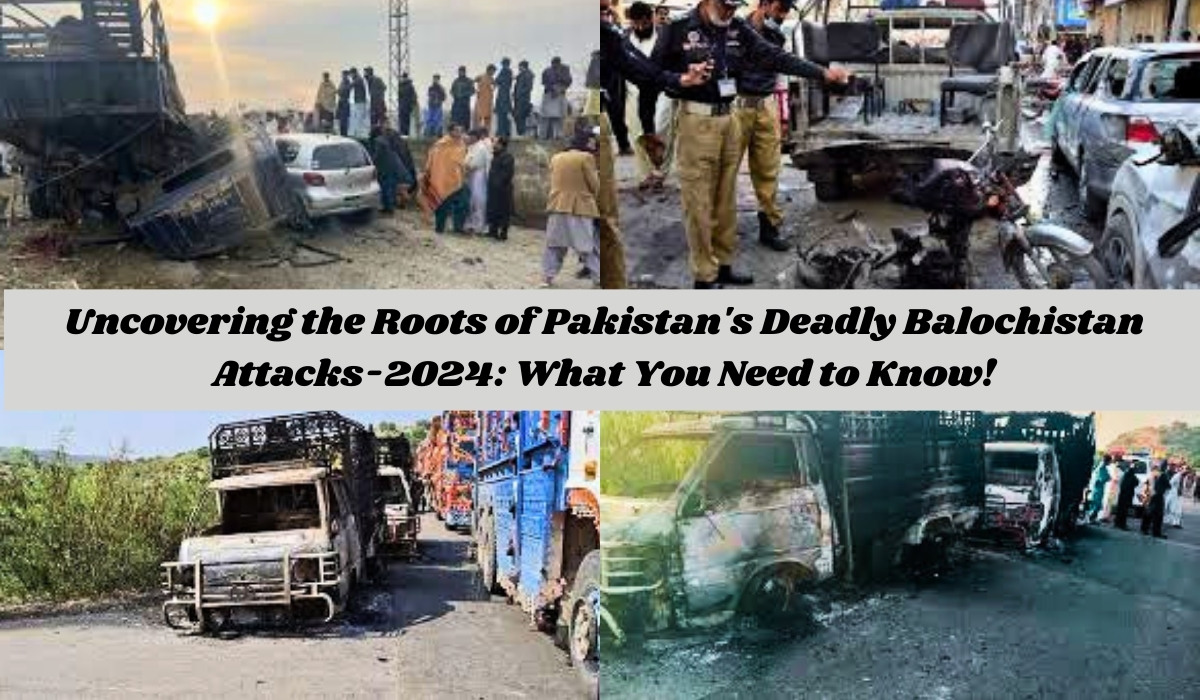Uncovering the Roots of Pakistan’s Deadly Balochistan Attacks-2024: What You Need to Know!

Description
Explore the underlying causes of the deadly Balochistan attacks in Pakistan that claimed 74 lives. Discover the escalating tensions, the role of separatist movements, and the government’s response in this comprehensive analysis.
A Surge in Violence with Deep-Rooted Causes
Balochistan, Pakistan’s largest yet most underdeveloped province, has been the epicenter of a deadly and protracted conflict. Recent attacks in the region have resulted in 74 fatalities, signaling a troubling escalation in violence. The province is no stranger to conflict, with separatist groups like the BalochistanLiberation Army (BELA) targeting security forces, civilians, and infrastructure in their struggle against the state. However, the recent surge in violence has raised serious concerns about the deteriorating security situation and its underlying causes.
The Escalation of Targeted Violence
The attacks that occurred across Balochistan on a recent Sunday night and Monday morning were particularly brutal. Nearly two dozen civilians traveling from Punjab were forcibly removed from their vehicles and executed by armed gunmen. This incident, along with several others that night, marked a dangerous escalation in the conflict. The BELA claimed responsibility, stating that they targeted security forces and seized control of highways throughout the province.
The timing of these attacks is significant, coinciding with the 18th death anniversary of Swab Akbar But, a former nationalist leader who joined the separatist movement in 2005 and was killed in a military operation in 2006. The attacks serve as a grim reminder of the enduring tensions between the separatists and the state, with the violence showing no signs of abating.
Table of statistics related to the Balochistan conflict:
| Statistic | Data | Source |
| Total Number of Attacks in Balochistan (2023) | 650+ | Pakistan Institute for Conflict and Security Studies (PICSS) |
| Percentage of Attacks in Balochistan (2023) | 23% | Pakistan Institute for Conflict and Security Studies (PICSS) |
| Deaths Due to Attacks in Balochistan (2023) | 286 | Pakistan Institute for Conflict and Security Studies (PICSS) |
| Number of Civilians Killed in Recent Attacks | 23 | Dawn News |
| Number of Security Personnel Killed in Recent Attacks | 14 | Al Jazeera |
| Total Number of Casualties in Recent Attacks | 74 | Al Jazeera |
| Balochistan Population (2023 Census) | 15 million | Pakistan Bureau of Statistics |
| Length of Balochistan Insurgency | Over 2 decades | BBC News |
| Balochistan’s Contribution to Federal Revenue | Significant (exact figures vary) | Various sources |
This table provides a clear and concise overview of the relevant statistics, making it easier to understand the scale and impact of the conflict in Baluchistan.
Understanding the Context and Seeking Resolution
To comprehend the recent surge in violence, it’s essential to examine the broader context of the Baluchistan conflict. The province, despite its wealth of natural resources, remains one of Pakistan’s most impoverished regions. Its resources, including oil, coal, gold, copper, and gas, significantly contribute to the federal government’s revenue, yet the local population sees little benefit. This perceived exploitation has fueled resentment and support for separatist movements like BELA.
The attacks also underscore a growing pattern of targeted violence against specific groups, including Punjabi laborers, security forces, and those involved in development projects. The separatists aim to convey a clear message that outsiders are unwelcome in Balochistan, a sentiment exacerbated by the region’s economic hardships.
Experts argue that the government’s heavy-handed approach to addressing the insurgency may be counterproductive. Engaging with peaceful protest groups, such as the Bloch Yakked Committee (BY), could provide a pathway to negotiations and diminish support for militant groups. However, the state’s refusal to engage with such groups only strengthens the resolve of the separatists, making it more challenging to achieve a peaceful resolution.
The Broader Implications: A Region on the Brink
The violence in Balochistan is not an isolated issue; it reflects broader regional instability, particularly following the Afghan Taliban’s return to power in 2021. The province’s unique geography, characterized by its scattered population and vast, rugged terrain, complicates both governance and insurgency efforts. As attacks continue to escalate, the government’s struggle to maintain control could lead to further alienation of the local population, driving more individuals to support the separatists.

Conclusion
The Urgency of a Pragmatic Approach
Balochistan’s conflict has reached a pivotal moment, and the government must embrace a more pragmatic and inclusive strategy to avert further bloodshed. The recent attacks highlight the province’s entrenched issues and the pressing need for a resolution. Leadership must acknowledge that, ultimately, war benefits no one, and only through dialogue and understanding can peace be attained in this troubled region.
References
- Al Jazeera – Provides comprehensive coverage of the Balochistan conflict and the recent attacks in the region.
- Al Jazeera Article on Balochistan Attacks
- Dawn News – Offers insights into the historical context of the Balochistan conflict and details on the separatist movements.
- Dawn News Balochistan Coverage
- BBC News – Covers the broader geopolitical implications of the conflict in Balochistan, including its impact on regional stability.
BBC News on Baluchistan Conflict



One thought on “Uncovering the Roots of Pakistan’s Deadly Balochistan Attacks-2024: What You Need to Know!”